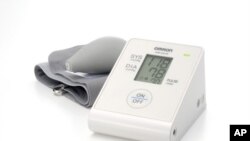A study of a solar-powered blood pressure monitor finds it can be an effective tool in places where electricity — and even batteries — can be in short supply. A study in Africa found the monitors to be affordable and accurate.
High blood pressure is a major health concern. It can lead to stroke and many other debilitating conditions. But you can't tell if someone has high blood pressure just by looking at them. You have to measure it, on regular basis. And that can be a challenge.
"And so, we have set out to find a device that is accurate, robust, inexpensive, and also not dependent on batteries or electricity for power," said Dr. Eoin O'Brien of University College Dublin, who is the lead author of a newly published study evaluating the effectiveness of these new monitors.
Taking blood pressure can be done manually, with an inflatable cuff and a stethoscope. The equipment is cheap, saiid O'Brien in a telephone interview, but it requires significant training to be accurate and reliable "because the greatest source of inaccuracy with the traditional technique is the observer.
"The observer becomes distracted or forgets what the blood pressure is. At least with the automated device you have the reading there. It's on the screen for you to see."
But automatic equipment requires batteries or plug-in electricity.
So the World Health Organization asked several manufacturers to submit solar-powered devices for evaluation. After laboratory review, the one made by the Japanese technology firm Omron was selected for field testing. On a full solar charge, it can take 300 blood pressure readings with accuracy comparable to the traditional, manual method.
In field tests in Uganda and Zambia, training users of the device only took about 15 minutes, and the health workers say they liked its ease of use.
"And also they liked the fact that they got automated measurements," O'Brien added, "that they had solar power and didn't have to worry about batteries, which is one of the problems with automated devices in that they are dependent upon batteries."
The Omron model HEM-SOLAR sells for around $32, but there are no ongoing costs for batteries or power. Eoin O'Brien's paper describing evaluation of the device is published online by Hypertension: Journal of the American Heart Association.








